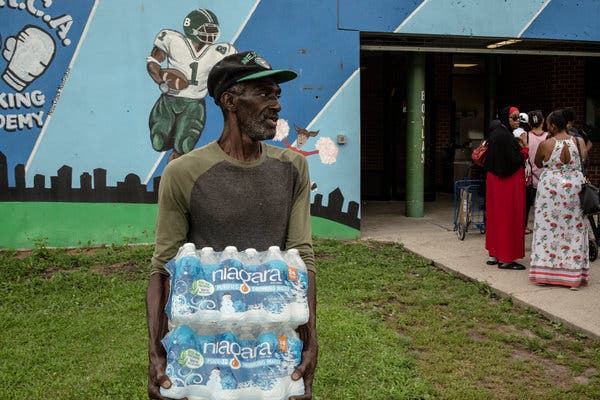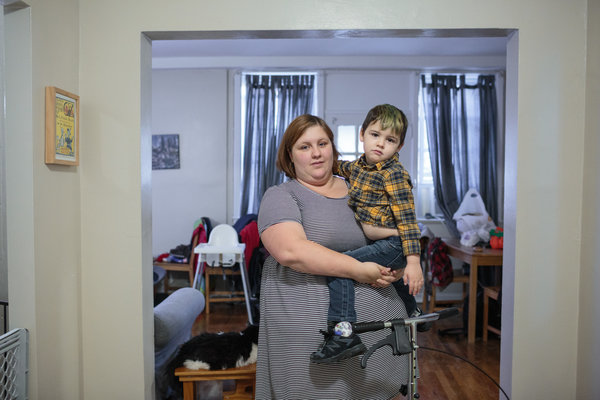NEWARK — A growing crisis over lead contamination in drinking water gripped Newark on Wednesday as tens of thousands of residents were told to drink only bottled water, the culmination of years of neglect that has pushed New Jersey’s largest city to the forefront of an environmental problem afflicting urban areas across the nation.
Urgent new warnings from federal environmental officials about contamination in drinking water from aging lead pipes spread anxiety and fear across much of Newark, but the municipal government’s makeshift efforts to set up distribution centers to hand out bottled water were hampered by confusion and frustration.
State and local officials said they were making free water available to 15,000 of the city’s 95,000 households, and hundreds of people waited in long lines in the summer heat to pick up cases of water. But officials had to halt the distribution temporarily after discovering that some of the water exceeded its best-by date.
The intensifying worry about the safety of Newark’s drinking water has raised comparisons to Flint, Mich, where dangerous levels of lead led to criminal indictments against state and local officials and forced residents to rely on bottled water.
The lead crisis in Newark, a city of 285,000 people, had been brewing for years, but escalated sharply over the weekend after federal officials issued a scathing letter warning about the safety of the drinking water and urging city officials to take more aggressive steps.
Elevated lead levels have been recorded in an expanding zone of the city and now includes all of the West and South Wards and parts of the Central and the North Wards.
While many communities rely on lead water pipes, Newark’s chronic financial challenges have made it difficult to upgrade its aging infrastructure. The situation was made worse because the city was slower than other places to address a flaw in a chemical compound that prevents lead from leaching into the water.
Residents who had been reassured for months by the mayor, Ras Baraka, the head of the water department and other city leaders that the problem was being addressed were left reeling and some have called for Mr. Baraka to step down.
Newark had long denied that the city had a widespread problem with its drinking water, only to reverse course last fall and give away tens of thousands of water filters. But recent tests have shown that the filters were not properly removing lead.
Like Flint, many of the neighborhoods affected by worries over the drinking water are predominantly African-American and low income.
On Wednesday, the governor of New Jersey, Philip D. Murphy, toured one of the water distribution centers, underscoring the severity of the problem.
“It’s a right, not a privilege, to have clean, safe water and we are committed to that,” Mr. Murphy said.
The state and city want “to get this as right, as fast as we can,” the governor said, calling on federal officials to help. “We take this very seriously. We want to be out ahead of this.”
Standing in long lines, residents expressed anger and fear over how wide-reaching the problem really was. Many said their anxiety over the water adds to the challenges the city already faces — from poverty to drugs.
“We’re ducking bullets, were ducking and dodging bullets every day,’’ said Nafessah Venable as she stood outside a recreation center with her young son. “We can’t even take our kids out to play. Now we’ve got to worry about water? Water is a necessity for life. How can we survive without clean water? It’s tragic, and it’s very mind-boggling to wonder what the future holds in terms of the water system.”
Newark’s antiquated plumbing system has long carried a threat of leached lead.
In 2016, annual testing of the water in Newark’s public schools revealed elevated lead levels; more than 30 schools shut off their water fountains and turned to bottled water.
In January 2017, a citywide testing system was put in place. Over the following 18 months, three consecutive tests found that 10 percent of Newark’s homes had water lead levels nearly twice the federal standard.
In October, the city began distributing PUR water filters, the same devices used to combat lead in Flint.
Scientists agree there is no safe level of lead in water. High blood lead levels can stunt a child’s mental development and damage organs. But even smaller amounts can affect children’s intellectual development.
The E.P.A.’s benchmark for addressing lead in drinking water — 15 parts per billion — is not based on a specific health threat. It reflects a calculation that the water in at least nine out of 10 homes susceptible to lead contamination will fall below that standard.
“They were in denial for a long period of time,” said Erik D. Olson, the senior director for health programs at the Natural Resources Defense Council, which filed a lawsuit against the state and the city last year, accusing them of violating federal safe drinking water laws.
“It’s been a slow response, but they’re finally coming around to realizing that they do have a serious problem, and that’s a good thing.”
The recreation center was one of four distribution points set up by the city to hand out water. Some people waited an hour to get their allotted two cases.

CreditBryan Anselm for The New York Times
Adding to the frustration, officials also turned away some people, telling them they were not eligible for free water because they did not live in an area identified as having elevated lead levels.
“When you get up there, they tell you you’ve got to be from a certain area to get the water,” said Leslie Holmon, a Newark grandmother, “but they didn’t tell you that on the news.”
She added, “They’ve got these seniors standing out here for nothing.”
Marguerite Royster, who had gone to the water distribution center with her grandson, said the trip was difficult.
“I’m not well, I’m not supposed to stand,” she said. “I’ve got plates and screws in my spine, had surgery. I fell down two fights of stairs at my job. So I’m really not supposed to be on my feet more than 15 to 20 minutes. But, this is a must. We have to have water.”
Though some of the bottled water had an expired best-by date, federal officials said it was still safe to drink. But city officials said they did not want to further alarm residents and those bottles were not given away.
Environmental and health advocates have criticized city officials for failing to adequately address a growing health threat that began three years ago when high lead levels were found in the drinking water at nearly half the city’s 67 schools, forcing some to shut down fountains and test thousands of children.
Still, Newark officials spent more than a year insisting that the city did not have an extensive water problem, declaring on the city’s website that the water was “absolutely safe to drink.’’

But Newark shifted and started handing out nearly 40,000 water filters after a state study found that lead was leaching into the water because of ineffective corrosion treatment at one of the two plants that treat the city’s drinking water.
On Friday, the E.P.A. urged officials to provide bottled water to residents with lead pipes as soon as possible.
“We are unable at this time to assure Newark residents that their health is fully protected when drinking tap water filtered through these devices,’’ the E.P.A. said in a letter, referring to the PUR filters issued by the city.
Some residents said the PUR filters did not even fit on their faucets. Gerald Webb, 66, said that after being unable to get his filter to work, he started paying for bottled water.
“They had let us know that there’s something wrong with the pipes, and now they say it’s in the water supply,” Mr. Webb said as he waited in line for water on Tuesday. “So, I don’t know. But we started doing bottles on our own months ago.”
Marc Edwards, a professor in the engineering department at Virginia Tech who has been involved in many water investigations, said lead most commonly gets into drinking water through lead pipes that run from water mains into homes. There are also possible sources within homes, including lead solder on pipes or brass fixtures with high lead content.
Generally, he said, those pipes and fixtures begin to shed lead when there are changes in the water supply that make the water more corrosive, causing the lead to leach from the pipes.
The lead pipes that run into the homes, known as service lines, are common in many older cities around the United States, affecting as many as 11 million homes, he said. Lead has been used in pipes that deliver water since ancient times, he noted, because it is long lasting and flexible. “Other than poisoning and killing people, it’s a great plumbing material,” he said. Many cities used to require their use, including Newark.
It has yet to be conclusively proved why the water became more corrosive, Mr. Olson said, but a city contractor noted that in 2015 Newark had tried to address a different issue with contaminants and “they adjusted their treatment” in ways that made the water more acidic.
“This change in water chemistry may have been responsible for Newark levels being so high now,” he said. “It’s an echo of Flint,” he said, referring to the lead contamination in that city’s water, which jumped when Flint chose a different, cheaper water source that was more corrosive, without taking action to counteract the effect of the more corrosive water.
The group’s lawsuit asks the court to order the city to treat the water with corrosion inhibitors, and to replace the old lead service lines. There is a hearing related to the lawsuit in Newark federal court on Thursday.
Nick Corasaniti reported from Newark, and Corey Kilgannon and John Schwartz from New York.

